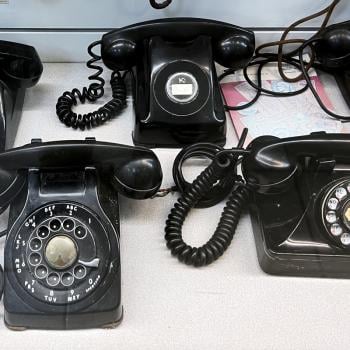Last week the amazing Misha Magdalene had a very helpful post titled So, You Want to Start a Pagan Blog: A Handful of Hard-Won Lessons. They overestimated my writing output, but other than that it’s excellent. If you’re considering starting your own blog – Pagan or otherwise – I encourage you to read the whole thing.
As it turns out, I’ve got my own list of blogging tips, gathered from numerous responses to “how do I get started blogging?” e-mail requests. Some of them overlap with Misha’s but there’s not much repetition, so I think both posts will be useful to new bloggers.
1. Find the right platform for you
The most frequent blog question I get is “how do I get a blog on Patheos?” My response is usually something along the lines of “how long have you been blogging where you are now?” If the answer is that the person doesn’t have a blog but thinks Patheos would be a good place to start, I point them toward some of the free blogging platforms currently available.
Patheos Pagan Channel Manager Jason Mankey (who has his own blogging tips, complete with extra snark) will publish new bloggers if you show him you can write well, but only on one of the group blogs like Agora. Show you can handle that and he’ll look at getting an individual blog set up for you.
If you want your own blog now – or if you’d rather be on your own anyway – you have several options. You can create your own website, but that’s expensive and time consuming. If you just want to blog you’ll be better off with one of the free blogging services, such as Blogger, WordPress.com, Medium, and others. Do some basic research, see what platforms people you follow use, and figure out which one is best for you.
2. Post weekly
There is no way around this. If you aren’t going to post at least once a week you have no business blogging. Oh, you can do it, but you’ll be doing it strictly for yourself. Building an audience requires posting regularly. People expect new content on a regular basis and if you don’t deliver they’ll lose patience and stop checking your blog.
A successful blog has a core audience of regular readers. Use social media to add to that core, rather than trying to generate a new audience for each post.
3. Post regularly
It’s not enough to post once a week. Post on the same days and at the same times. Teach your audience when to expect new posts and they’ll come looking for them.
All the blogging services I’m familiar with allow you to load a post ahead of time and schedule it to publish whenever you like. Use that functionality.
And that’s another tip – don’t write on the website. Write in Word, then copy and paste into the blogging site. That way you’ve got a saved copy in case something goes wrong… and something always goes wrong sooner or later.
And while you simply must post regularly, write when you’re able. This is the one place I disagree with Misha Magdalene. If I tried to write every day I’d drive myself insane. There are days when the Awen isn’t flowing, or when I’ve got too much to do and writing one paragraph just to say I wrote that day would be meaningless.
Just know when your next posting day is and have something finished before it gets here.
4. Promote your blog on social media
The internet is huge and your blog is small – do everything you can to help people find it. Share your posts on all your social media accounts. Facebook will tell you to create a page for your blog. Jason Mankey and Mat Auryn have had success with that – I’ve found it to be a waste of time.
Facebook doesn’t want to share blog posts – they want to keep you on their site. My Facebook posts linking to blog posts get only about 1/3 as many likes as ones without links. But getting some traffic from Facebook is better than getting nothing. Twitter is generally better, if you have a large Twitter following.
Facebook groups can be a good place to share posts, but first make sure that’s an acceptable use of that group. Some explicitly forbid self-promotion, while others appreciate occasional posts but don’t want to see everything you write. But you can always post on your own page, and you should.
5. Build your own subscribers list
Every time Facebook changes its algorithm, my pageviews go down. Those who work from author pages or business pages say they’re lucky if Facebook will show their post to 5% of their audience. They’ll be happy to show it to more – if you’ll pay them to do it.
Relying on a third party whose goal is to extract wealth from you to build your blog is a losing strategy. Most blogging services have subscription options – encourage your readers to sign up. That way they’ll get an e-mail every time you post something new.
6. Find the post length you’re comfortable with
For me, this is around 1500 words, plus or minus 300. Never post less than 500 words. Google – another necessary evil – penalizes websites with short content. Plus you can’t really say much in less than 500 words.
On the other hand, if you get much above 2500 words people just won’t read it. If your writing style is long-form essays, that’s fine, but know that you’re limiting your audience. The worst thing you can do is write 1500 words this week, 600 next week, and 3000 the week after. Long-form, short-form, and medium form appeal to different readers. Pick one range and stick with it.
If you want a target when you’re starting out, aim for 1000 words. Over time you’ll find your sweet spot.
7. Every post gets at least one image
Facebook posts with pictures get substantially more click-throughs than those without. Pictures add variety to a post, they help illustrate what you’re writing about, and they make the page look interesting.
I trust you know you can’t just grab any image you find on the internet. Use your own photography, find one of the royalty-free sites, or search for things that can be posted under a creative commons license. If it’s not your picture, credit the source – but credit alone isn’t enough. Using other people’s images without permission is a good way to get sued.

8. Make your posts easy to read
Nothing will make me hit the “back” button faster than a Wall Of Text. If it’s a writer I really respect writing on a topic I really care about I’ll try to make myself wade through it, but that takes work. Most people will give up.
Use section headings. No long paragraphs – four sentences at most, and regardless of what your freshman English teacher told you, one-sentence paragraphs are fine. Think “USA Today.”
Not sure what I’m talking about? Click through a few blog posts here. My blog isn’t perfect, but it’s better than most.
9. Write about what you know and what you’re passionate about
The clichéd instructions to new writers is “write what you know, not what you think you know.” I don’t have Jason Mankey’s knowledge of modern Pagan history or Morgan Daimler’s knowledge of fairy lore. I’m not an expert on Paganism. I’m someone who does Paganism and then writes about what I do. And sometimes about what I think.
What do you know? What do you do that you can write about? What are you passionate about learning? Some blogs aren’t intended to teach others – they’re a way to share the blogger’s spiritual journey, something many readers find helpful and inspiring.
Write what you know and what matters to you. If you have to force it, it’s probably going to suck.

10. Speak your mind but check your facts
A blog is by definition your opinion. There is no need to add disclaimers of “in my opinion” for everything you write – I find that annoying. If you’re trying to lead people to a conclusion, state your assumptions, present your evidence, and explain your reasoning.
On the other hand, if you state something as fact, make sure it really is a fact. In this era of Google and Snopes, there is simply no excuse for posting false information. And if you do, someone will call you on it. Check your facts before you hit “post.”
11. Continue on-going conversations
Blog for very long and you’ll find yourself scratching your head looking for things to write about. One of the best ways to come up with something is to continue a conversation someone else has started.
That’s what I did here. Misha had a good post and I had something to say on the same topic. Don’t plagiarize and don’t be repetitious, but different perspectives on a topic can be very helpful to readers.
Make sure you link to the blog posts that inspired you. That credits your sources and also lets your readers go back and read it for themselves.
12. Use in-line links to reference source material
Which brings us to the subject of in-line links. Use them judiciously. Add too many and you look like some scam page trying to trick readers into clicking on ads (or worse, malware). But where you use a term that most but not all of your audience will understand, link to a definition rather than spending time defining it yourself. Link to your own posts, both as context and to encourage new readers to explore your blog. Always link to source material, like I did with Misha’s post.
Be careful what sites you link to. Link to high quality sites (mainstream media, academic sources) and Google will raise you in their rankings. Link to low quality sites (clickbait news sites) and they’ll lower you.
13. Look at comments – listen to people who make sense.
We’re all warned “never read the comments.” I think you have to look at the comments.
If somebody posts garbage or hate speech on your site (or on your Facebook page) delete it. If they do it repeatedly, block them (most blogging platforms have that functionality). This isn’t the public square – it’s your blog. You don’t owe anybody a platform.
If somebody posts false information, either delete it or rebut it. If they continue, block them. Don’t let “fake news” sit on your blog, even in the comments section.
If they simply disagree with you, respond or not at your sole discretion. You don’t owe anybody a debate. I tend to be generous here – I like debating, if it’s done in good faith. I won’t put up with sealioning, and even with a good debate sometimes I have to say “I’m out of time for this.”
On the other hand, if someone points out an error, correct it. Your goal is to be right, not to pretend you’re perfect.

14. Be patient with building an audience
Don’t expect thousands of pageviews overnight. It took me 18 months to get out of the double digits, and about three years to get to the point where I had what I considered a decent-sized audience. If you want to be an overnight success, blogging isn’t for you.
Blog because you have something you want to say. Do it well and the audience will come, sooner or later.
15. Come on in, the water’s fine
I keep reading articles that say blogging is outdated. Perhaps that’s true if you’re trying to promote a business or build a brand. But if you want to start a conversation on Paganism or some other topic, or if there are things you want to say, there’s no better way to do it.
I’ve been blogging for 11 years now. It hasn’t all been fun, but it’s mostly been fun, and I plan to continue blogging for the foreseeable future.
The readership for blogs isn’t fixed. Good writing motivates people to look for more good writing – the more good Pagan blogs we have the better we all do. There’s room for you too.



















